HSC Organizational Structure and Leadership Report
VerifiedAdded on 2020/01/16
|15
|3517
|180
Report
AI Summary
This report analyzes the organizational structure and leadership within the Health and Social Care (HSC) sector, using the Voluntary Service Overseas (VSO) as a case study. It compares different organizational structures, such as flat and tall hierarchies, and examines the impact of organizational culture on service delivery. The report also delves into individual and group behavior theories, including Herzberg's two-factor theory and Belbin's team roles. Furthermore, it discusses various leadership styles, such as transformational leadership, and evaluates their influence on the effectiveness of HSC organizations. The report concludes that VSO's adoption of a flat structure, power culture, and participative leadership significantly impacts its service delivery and overall performance.
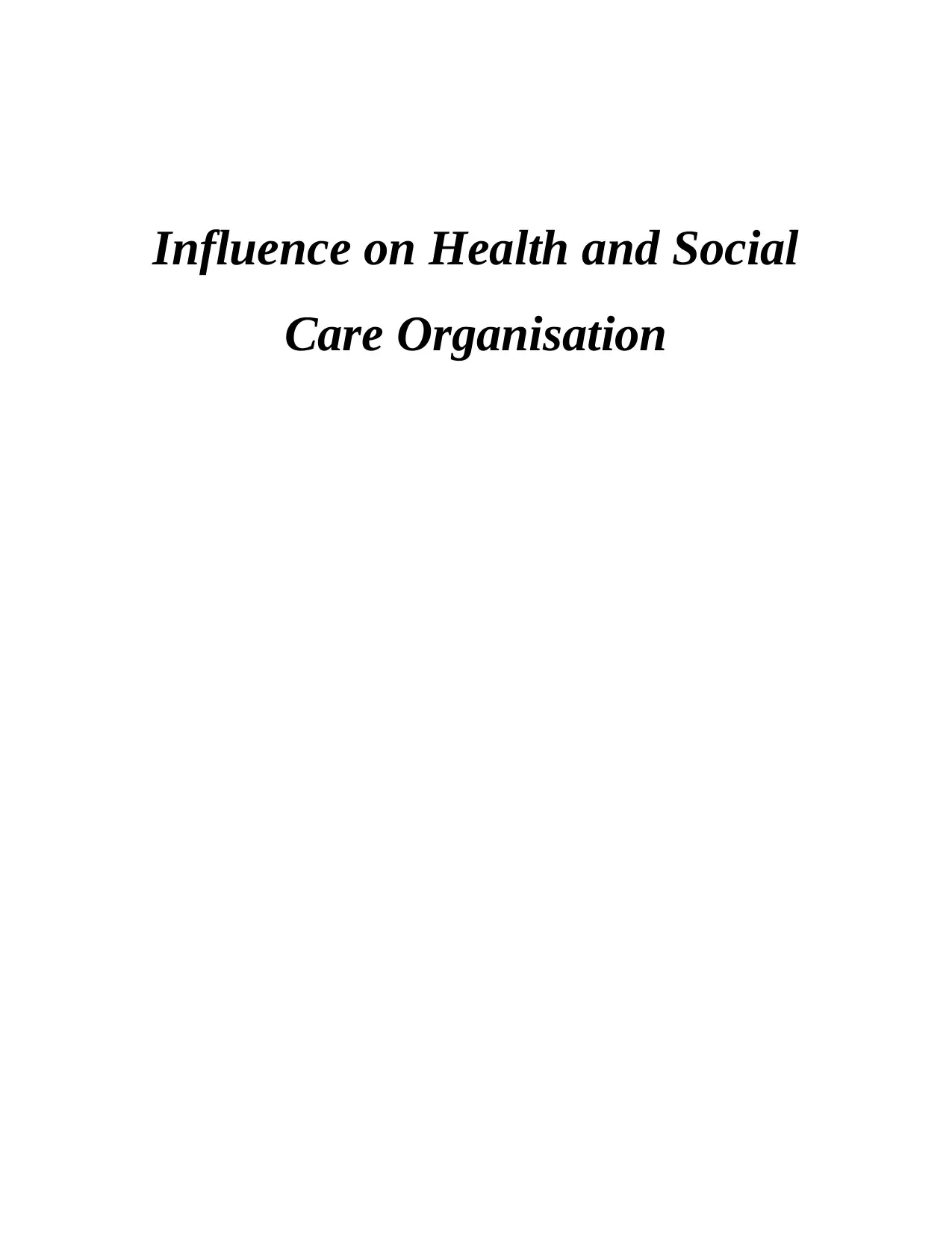
Influence on Health and Social
Care Organisation
Care Organisation
Paraphrase This Document
Need a fresh take? Get an instant paraphrase of this document with our AI Paraphraser

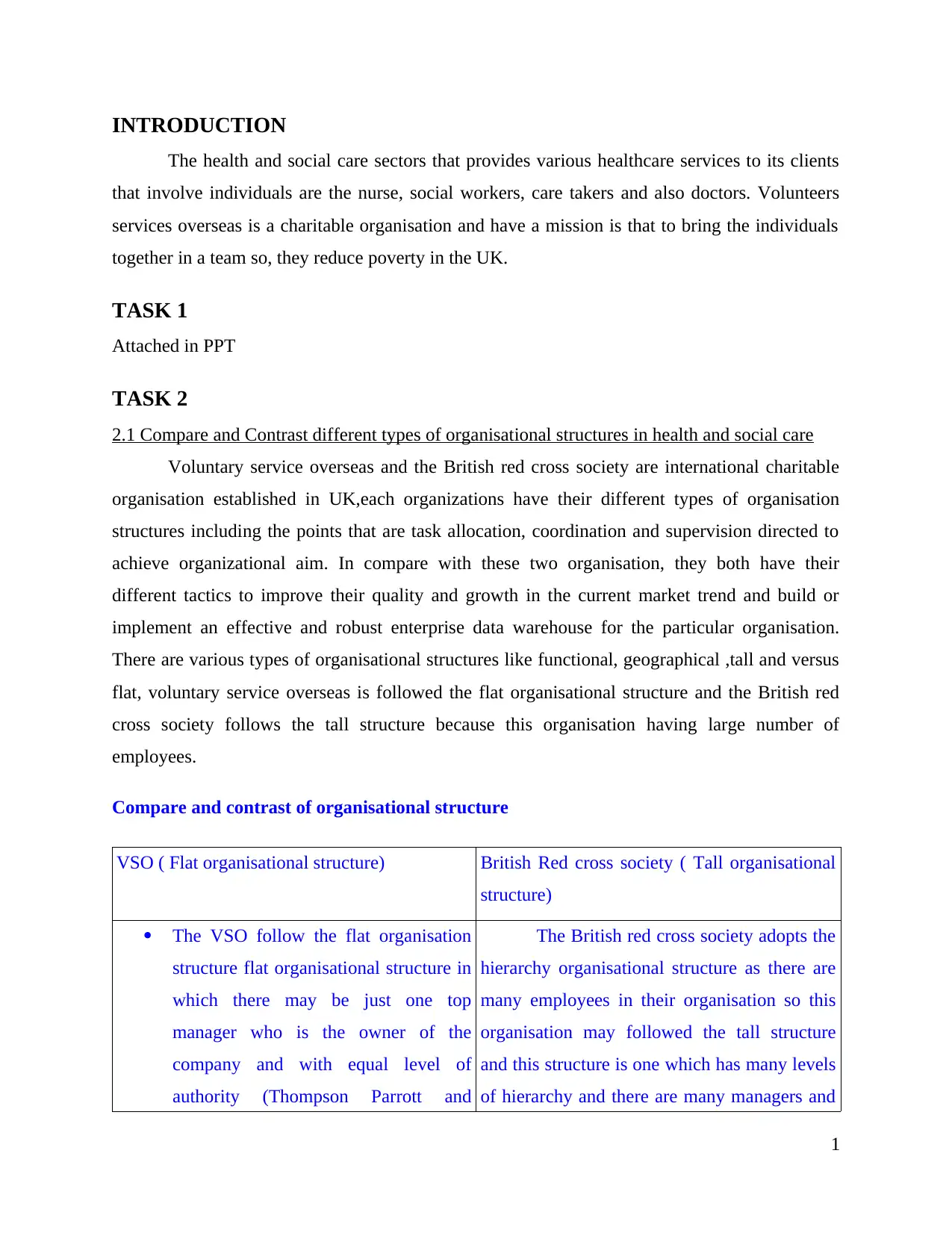
INTRODUCTION
The health and social care sectors that provides various healthcare services to its clients
that involve individuals are the nurse, social workers, care takers and also doctors. Volunteers
services overseas is a charitable organisation and have a mission is that to bring the individuals
together in a team so, they reduce poverty in the UK.
TASK 1
Attached in PPT
TASK 2
2.1 Compare and Contrast different types of organisational structures in health and social care
Voluntary service overseas and the British red cross society are international charitable
organisation established in UK,each organizations have their different types of organisation
structures including the points that are task allocation, coordination and supervision directed to
achieve organizational aim. In compare with these two organisation, they both have their
different tactics to improve their quality and growth in the current market trend and build or
implement an effective and robust enterprise data warehouse for the particular organisation.
There are various types of organisational structures like functional, geographical ,tall and versus
flat, voluntary service overseas is followed the flat organisational structure and the British red
cross society follows the tall structure because this organisation having large number of
employees.
Compare and contrast of organisational structure
VSO ( Flat organisational structure) British Red cross society ( Tall organisational
structure)
The VSO follow the flat organisation
structure flat organisational structure in
which there may be just one top
manager who is the owner of the
company and with equal level of
authority (Thompson Parrott and
The British red cross society adopts the
hierarchy organisational structure as there are
many employees in their organisation so this
organisation may followed the tall structure
and this structure is one which has many levels
of hierarchy and there are many managers and
1
The health and social care sectors that provides various healthcare services to its clients
that involve individuals are the nurse, social workers, care takers and also doctors. Volunteers
services overseas is a charitable organisation and have a mission is that to bring the individuals
together in a team so, they reduce poverty in the UK.
TASK 1
Attached in PPT
TASK 2
2.1 Compare and Contrast different types of organisational structures in health and social care
Voluntary service overseas and the British red cross society are international charitable
organisation established in UK,each organizations have their different types of organisation
structures including the points that are task allocation, coordination and supervision directed to
achieve organizational aim. In compare with these two organisation, they both have their
different tactics to improve their quality and growth in the current market trend and build or
implement an effective and robust enterprise data warehouse for the particular organisation.
There are various types of organisational structures like functional, geographical ,tall and versus
flat, voluntary service overseas is followed the flat organisational structure and the British red
cross society follows the tall structure because this organisation having large number of
employees.
Compare and contrast of organisational structure
VSO ( Flat organisational structure) British Red cross society ( Tall organisational
structure)
The VSO follow the flat organisation
structure flat organisational structure in
which there may be just one top
manager who is the owner of the
company and with equal level of
authority (Thompson Parrott and
The British red cross society adopts the
hierarchy organisational structure as there are
many employees in their organisation so this
organisation may followed the tall structure
and this structure is one which has many levels
of hierarchy and there are many managers and
1
⊘ This is a preview!⊘
Do you want full access?
Subscribe today to unlock all pages.

Trusted by 1+ million students worldwide
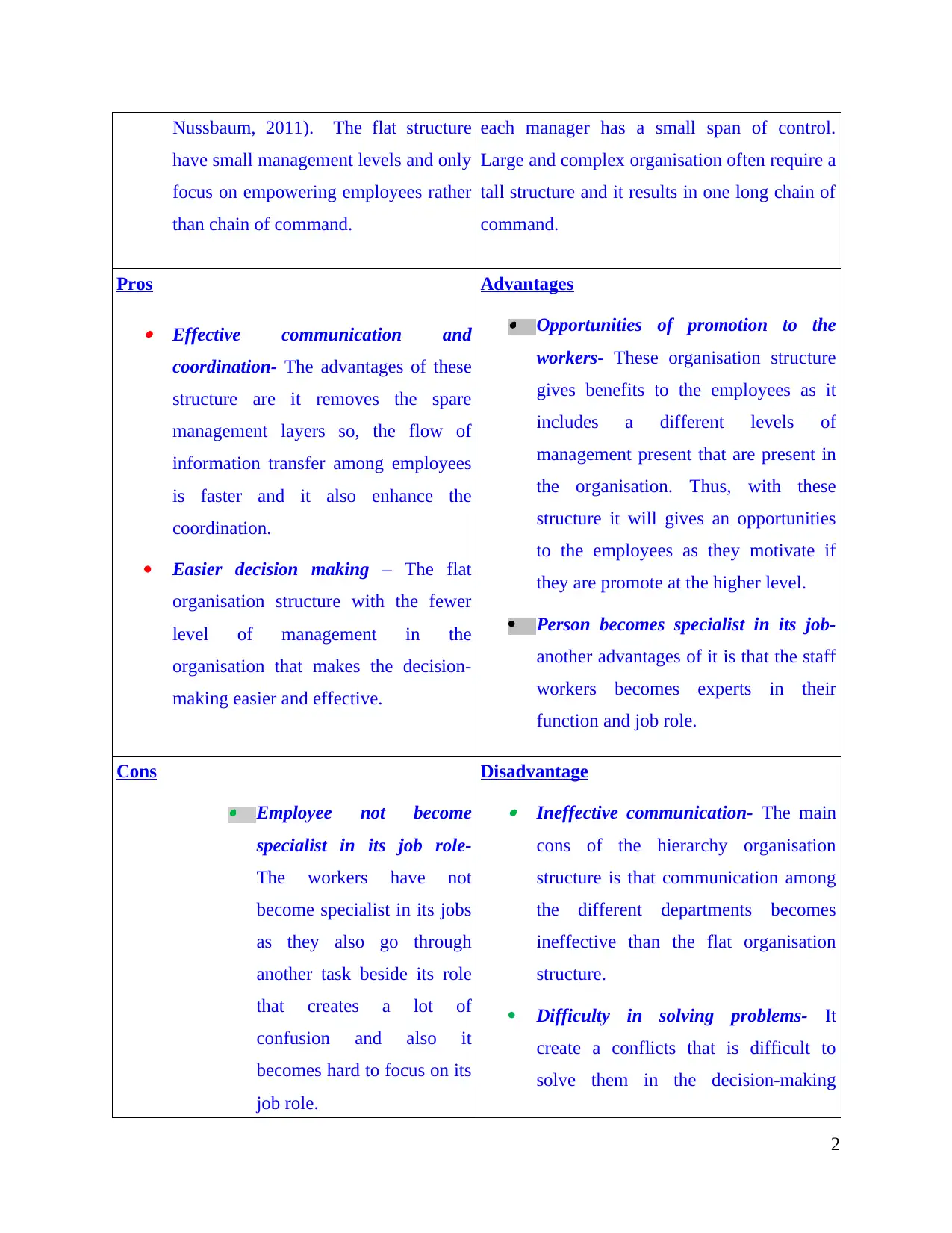
Nussbaum, 2011). The flat structure
have small management levels and only
focus on empowering employees rather
than chain of command.
each manager has a small span of control.
Large and complex organisation often require a
tall structure and it results in one long chain of
command.
Pros
Effective communication and
coordination- The advantages of these
structure are it removes the spare
management layers so, the flow of
information transfer among employees
is faster and it also enhance the
coordination.
Easier decision making – The flat
organisation structure with the fewer
level of management in the
organisation that makes the decision-
making easier and effective.
Advantages
Opportunities of promotion to the
workers- These organisation structure
gives benefits to the employees as it
includes a different levels of
management present that are present in
the organisation. Thus, with these
structure it will gives an opportunities
to the employees as they motivate if
they are promote at the higher level.
Person becomes specialist in its job-
another advantages of it is that the staff
workers becomes experts in their
function and job role.
Cons
Employee not become
specialist in its job role-
The workers have not
become specialist in its jobs
as they also go through
another task beside its role
that creates a lot of
confusion and also it
becomes hard to focus on its
job role.
Disadvantage
Ineffective communication- The main
cons of the hierarchy organisation
structure is that communication among
the different departments becomes
ineffective than the flat organisation
structure.
Difficulty in solving problems- It
create a conflicts that is difficult to
solve them in the decision-making
2
have small management levels and only
focus on empowering employees rather
than chain of command.
each manager has a small span of control.
Large and complex organisation often require a
tall structure and it results in one long chain of
command.
Pros
Effective communication and
coordination- The advantages of these
structure are it removes the spare
management layers so, the flow of
information transfer among employees
is faster and it also enhance the
coordination.
Easier decision making – The flat
organisation structure with the fewer
level of management in the
organisation that makes the decision-
making easier and effective.
Advantages
Opportunities of promotion to the
workers- These organisation structure
gives benefits to the employees as it
includes a different levels of
management present that are present in
the organisation. Thus, with these
structure it will gives an opportunities
to the employees as they motivate if
they are promote at the higher level.
Person becomes specialist in its job-
another advantages of it is that the staff
workers becomes experts in their
function and job role.
Cons
Employee not become
specialist in its job role-
The workers have not
become specialist in its jobs
as they also go through
another task beside its role
that creates a lot of
confusion and also it
becomes hard to focus on its
job role.
Disadvantage
Ineffective communication- The main
cons of the hierarchy organisation
structure is that communication among
the different departments becomes
ineffective than the flat organisation
structure.
Difficulty in solving problems- It
create a conflicts that is difficult to
solve them in the decision-making
2
Paraphrase This Document
Need a fresh take? Get an instant paraphrase of this document with our AI Paraphraser
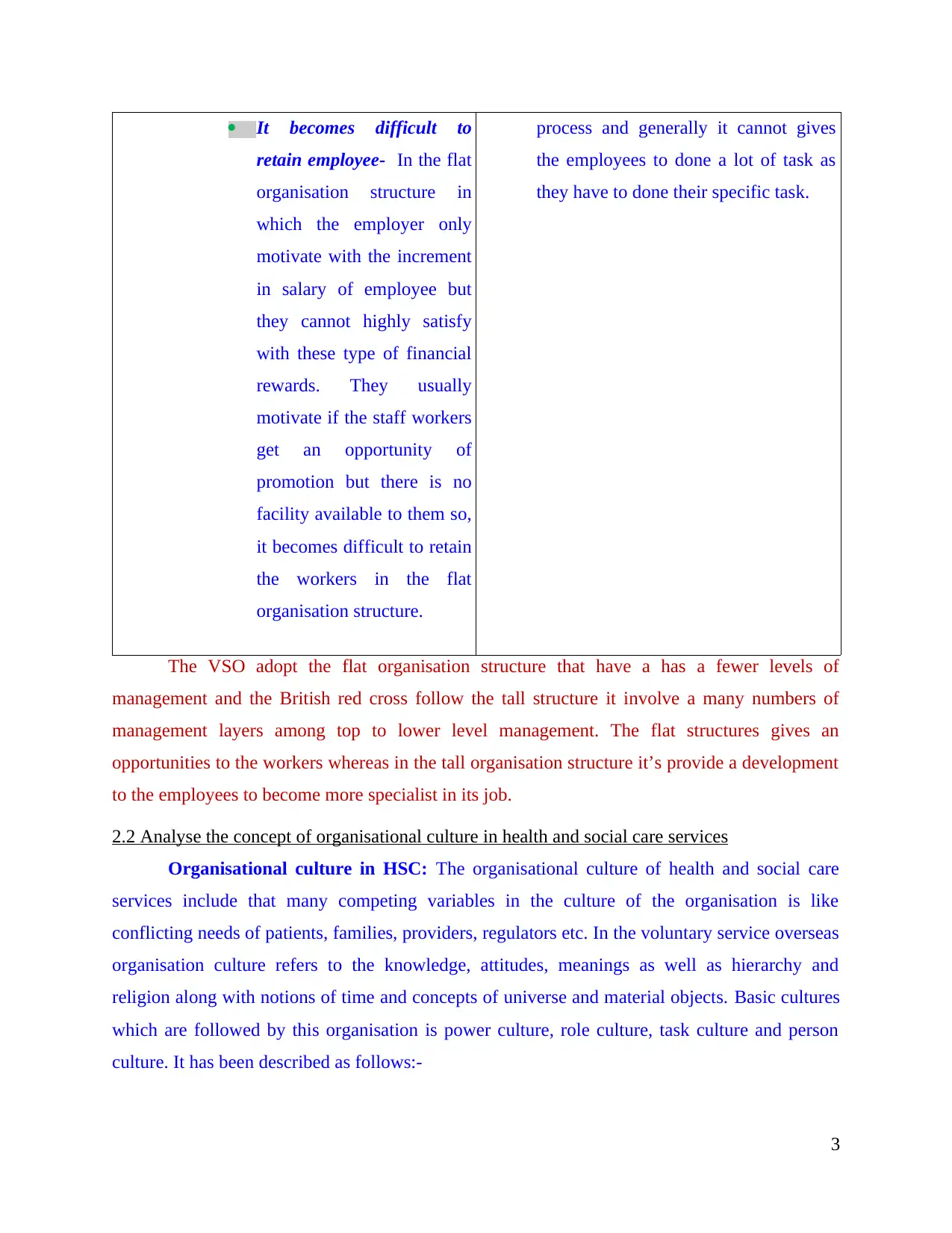
It becomes difficult to
retain employee- In the flat
organisation structure in
which the employer only
motivate with the increment
in salary of employee but
they cannot highly satisfy
with these type of financial
rewards. They usually
motivate if the staff workers
get an opportunity of
promotion but there is no
facility available to them so,
it becomes difficult to retain
the workers in the flat
organisation structure.
process and generally it cannot gives
the employees to done a lot of task as
they have to done their specific task.
The VSO adopt the flat organisation structure that have a has a fewer levels of
management and the British red cross follow the tall structure it involve a many numbers of
management layers among top to lower level management. The flat structures gives an
opportunities to the workers whereas in the tall organisation structure it’s provide a development
to the employees to become more specialist in its job.
2.2 Analyse the concept of organisational culture in health and social care services
Organisational culture in HSC: The organisational culture of health and social care
services include that many competing variables in the culture of the organisation is like
conflicting needs of patients, families, providers, regulators etc. In the voluntary service overseas
organisation culture refers to the knowledge, attitudes, meanings as well as hierarchy and
religion along with notions of time and concepts of universe and material objects. Basic cultures
which are followed by this organisation is power culture, role culture, task culture and person
culture. It has been described as follows:-
3
retain employee- In the flat
organisation structure in
which the employer only
motivate with the increment
in salary of employee but
they cannot highly satisfy
with these type of financial
rewards. They usually
motivate if the staff workers
get an opportunity of
promotion but there is no
facility available to them so,
it becomes difficult to retain
the workers in the flat
organisation structure.
process and generally it cannot gives
the employees to done a lot of task as
they have to done their specific task.
The VSO adopt the flat organisation structure that have a has a fewer levels of
management and the British red cross follow the tall structure it involve a many numbers of
management layers among top to lower level management. The flat structures gives an
opportunities to the workers whereas in the tall organisation structure it’s provide a development
to the employees to become more specialist in its job.
2.2 Analyse the concept of organisational culture in health and social care services
Organisational culture in HSC: The organisational culture of health and social care
services include that many competing variables in the culture of the organisation is like
conflicting needs of patients, families, providers, regulators etc. In the voluntary service overseas
organisation culture refers to the knowledge, attitudes, meanings as well as hierarchy and
religion along with notions of time and concepts of universe and material objects. Basic cultures
which are followed by this organisation is power culture, role culture, task culture and person
culture. It has been described as follows:-
3
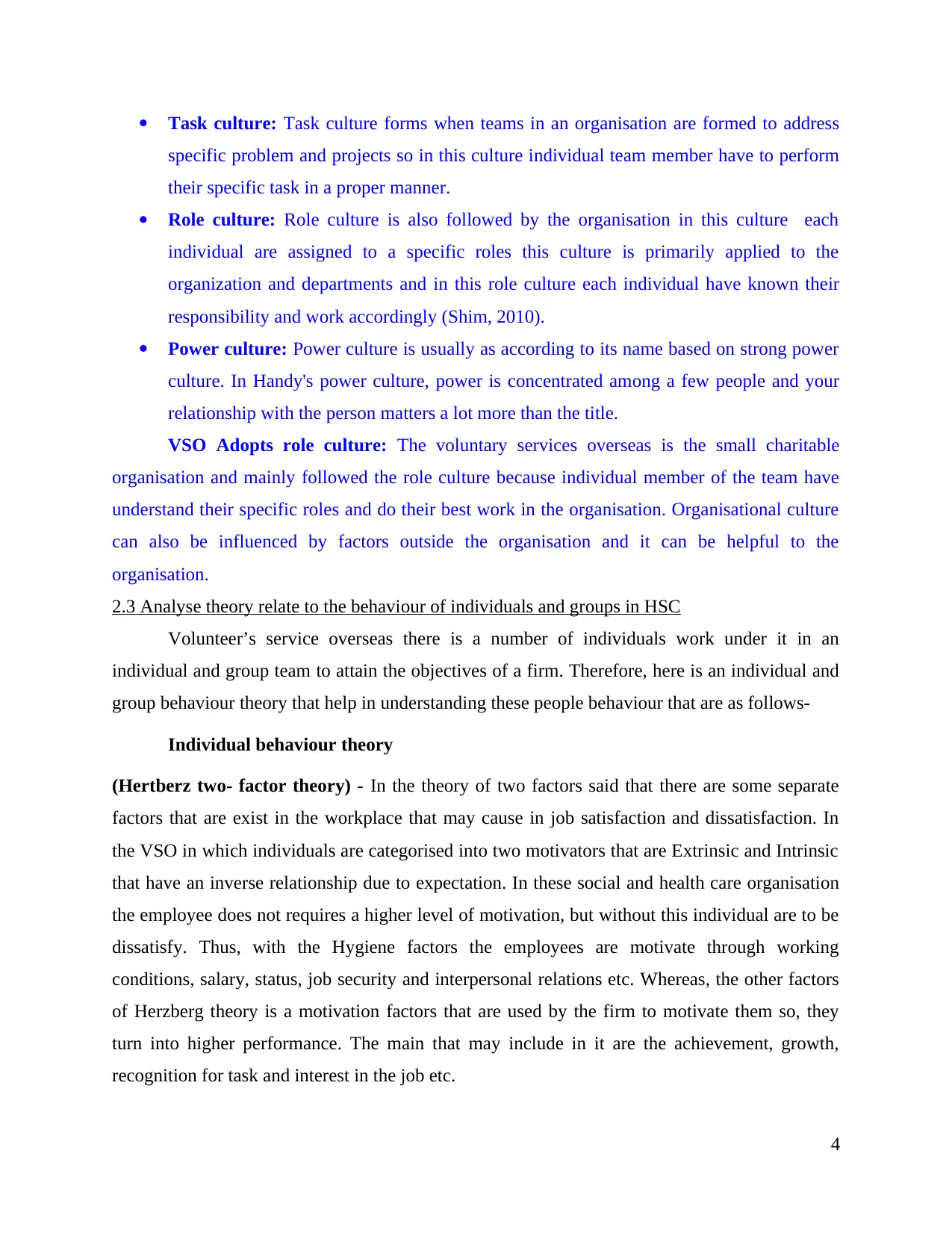
Task culture: Task culture forms when teams in an organisation are formed to address
specific problem and projects so in this culture individual team member have to perform
their specific task in a proper manner.
Role culture: Role culture is also followed by the organisation in this culture each
individual are assigned to a specific roles this culture is primarily applied to the
organization and departments and in this role culture each individual have known their
responsibility and work accordingly (Shim, 2010).
Power culture: Power culture is usually as according to its name based on strong power
culture. In Handy's power culture, power is concentrated among a few people and your
relationship with the person matters a lot more than the title.
VSO Adopts role culture: The voluntary services overseas is the small charitable
organisation and mainly followed the role culture because individual member of the team have
understand their specific roles and do their best work in the organisation. Organisational culture
can also be influenced by factors outside the organisation and it can be helpful to the
organisation.
2.3 Analyse theory relate to the behaviour of individuals and groups in HSC
Volunteer’s service overseas there is a number of individuals work under it in an
individual and group team to attain the objectives of a firm. Therefore, here is an individual and
group behaviour theory that help in understanding these people behaviour that are as follows-
Individual behaviour theory
(Hertberz two- factor theory) - In the theory of two factors said that there are some separate
factors that are exist in the workplace that may cause in job satisfaction and dissatisfaction. In
the VSO in which individuals are categorised into two motivators that are Extrinsic and Intrinsic
that have an inverse relationship due to expectation. In these social and health care organisation
the employee does not requires a higher level of motivation, but without this individual are to be
dissatisfy. Thus, with the Hygiene factors the employees are motivate through working
conditions, salary, status, job security and interpersonal relations etc. Whereas, the other factors
of Herzberg theory is a motivation factors that are used by the firm to motivate them so, they
turn into higher performance. The main that may include in it are the achievement, growth,
recognition for task and interest in the job etc.
4
specific problem and projects so in this culture individual team member have to perform
their specific task in a proper manner.
Role culture: Role culture is also followed by the organisation in this culture each
individual are assigned to a specific roles this culture is primarily applied to the
organization and departments and in this role culture each individual have known their
responsibility and work accordingly (Shim, 2010).
Power culture: Power culture is usually as according to its name based on strong power
culture. In Handy's power culture, power is concentrated among a few people and your
relationship with the person matters a lot more than the title.
VSO Adopts role culture: The voluntary services overseas is the small charitable
organisation and mainly followed the role culture because individual member of the team have
understand their specific roles and do their best work in the organisation. Organisational culture
can also be influenced by factors outside the organisation and it can be helpful to the
organisation.
2.3 Analyse theory relate to the behaviour of individuals and groups in HSC
Volunteer’s service overseas there is a number of individuals work under it in an
individual and group team to attain the objectives of a firm. Therefore, here is an individual and
group behaviour theory that help in understanding these people behaviour that are as follows-
Individual behaviour theory
(Hertberz two- factor theory) - In the theory of two factors said that there are some separate
factors that are exist in the workplace that may cause in job satisfaction and dissatisfaction. In
the VSO in which individuals are categorised into two motivators that are Extrinsic and Intrinsic
that have an inverse relationship due to expectation. In these social and health care organisation
the employee does not requires a higher level of motivation, but without this individual are to be
dissatisfy. Thus, with the Hygiene factors the employees are motivate through working
conditions, salary, status, job security and interpersonal relations etc. Whereas, the other factors
of Herzberg theory is a motivation factors that are used by the firm to motivate them so, they
turn into higher performance. The main that may include in it are the achievement, growth,
recognition for task and interest in the job etc.
4
⊘ This is a preview!⊘
Do you want full access?
Subscribe today to unlock all pages.

Trusted by 1+ million students worldwide
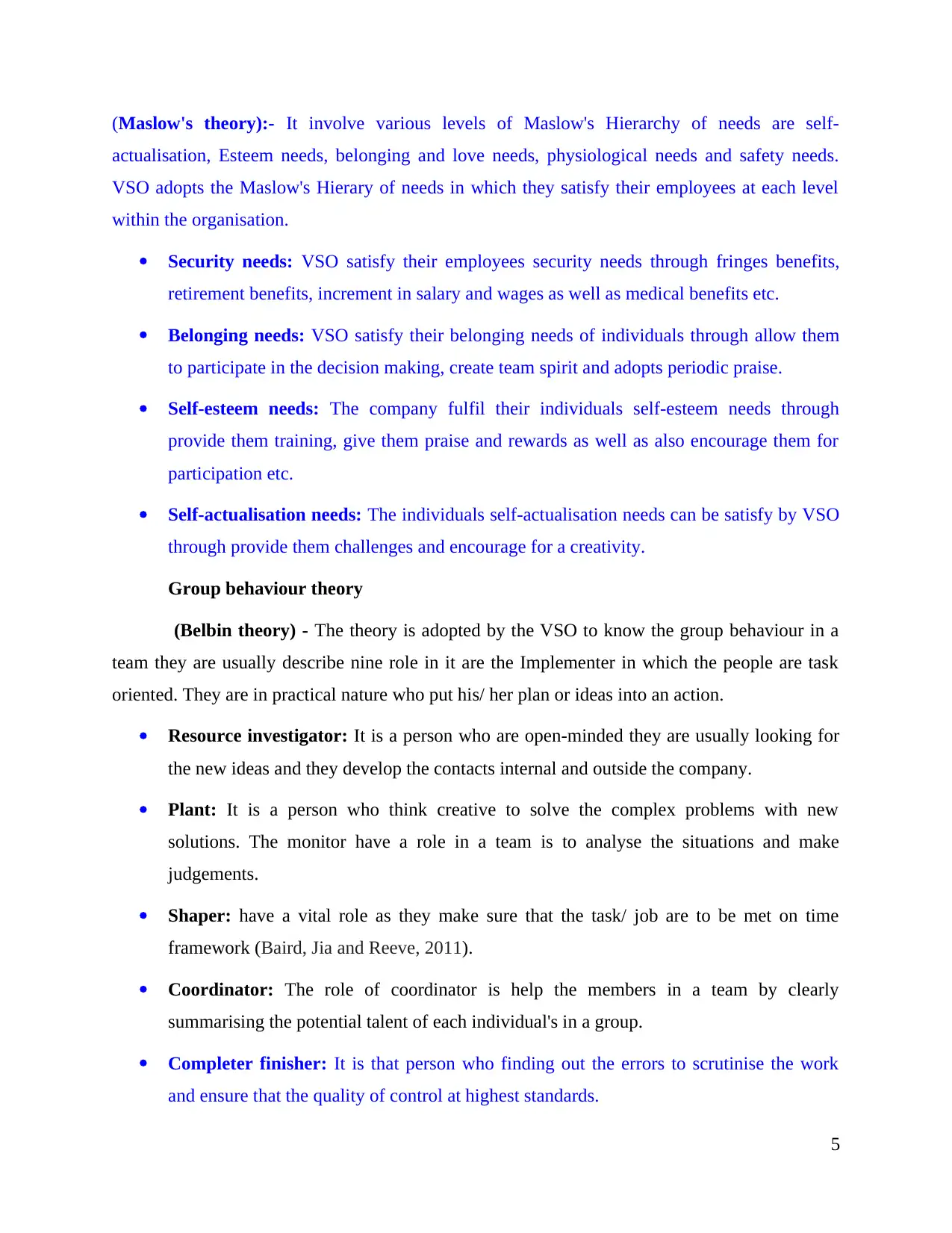
(Maslow's theory):- It involve various levels of Maslow's Hierarchy of needs are self-
actualisation, Esteem needs, belonging and love needs, physiological needs and safety needs.
VSO adopts the Maslow's Hierary of needs in which they satisfy their employees at each level
within the organisation.
Security needs: VSO satisfy their employees security needs through fringes benefits,
retirement benefits, increment in salary and wages as well as medical benefits etc.
Belonging needs: VSO satisfy their belonging needs of individuals through allow them
to participate in the decision making, create team spirit and adopts periodic praise.
Self-esteem needs: The company fulfil their individuals self-esteem needs through
provide them training, give them praise and rewards as well as also encourage them for
participation etc.
Self-actualisation needs: The individuals self-actualisation needs can be satisfy by VSO
through provide them challenges and encourage for a creativity.
Group behaviour theory
(Belbin theory) - The theory is adopted by the VSO to know the group behaviour in a
team they are usually describe nine role in it are the Implementer in which the people are task
oriented. They are in practical nature who put his/ her plan or ideas into an action.
Resource investigator: It is a person who are open-minded they are usually looking for
the new ideas and they develop the contacts internal and outside the company.
Plant: It is a person who think creative to solve the complex problems with new
solutions. The monitor have a role in a team is to analyse the situations and make
judgements.
Shaper: have a vital role as they make sure that the task/ job are to be met on time
framework (Baird, Jia and Reeve, 2011).
Coordinator: The role of coordinator is help the members in a team by clearly
summarising the potential talent of each individual's in a group.
Completer finisher: It is that person who finding out the errors to scrutinise the work
and ensure that the quality of control at highest standards.
5
actualisation, Esteem needs, belonging and love needs, physiological needs and safety needs.
VSO adopts the Maslow's Hierary of needs in which they satisfy their employees at each level
within the organisation.
Security needs: VSO satisfy their employees security needs through fringes benefits,
retirement benefits, increment in salary and wages as well as medical benefits etc.
Belonging needs: VSO satisfy their belonging needs of individuals through allow them
to participate in the decision making, create team spirit and adopts periodic praise.
Self-esteem needs: The company fulfil their individuals self-esteem needs through
provide them training, give them praise and rewards as well as also encourage them for
participation etc.
Self-actualisation needs: The individuals self-actualisation needs can be satisfy by VSO
through provide them challenges and encourage for a creativity.
Group behaviour theory
(Belbin theory) - The theory is adopted by the VSO to know the group behaviour in a
team they are usually describe nine role in it are the Implementer in which the people are task
oriented. They are in practical nature who put his/ her plan or ideas into an action.
Resource investigator: It is a person who are open-minded they are usually looking for
the new ideas and they develop the contacts internal and outside the company.
Plant: It is a person who think creative to solve the complex problems with new
solutions. The monitor have a role in a team is to analyse the situations and make
judgements.
Shaper: have a vital role as they make sure that the task/ job are to be met on time
framework (Baird, Jia and Reeve, 2011).
Coordinator: The role of coordinator is help the members in a team by clearly
summarising the potential talent of each individual's in a group.
Completer finisher: It is that person who finding out the errors to scrutinise the work
and ensure that the quality of control at highest standards.
5
Paraphrase This Document
Need a fresh take? Get an instant paraphrase of this document with our AI Paraphraser
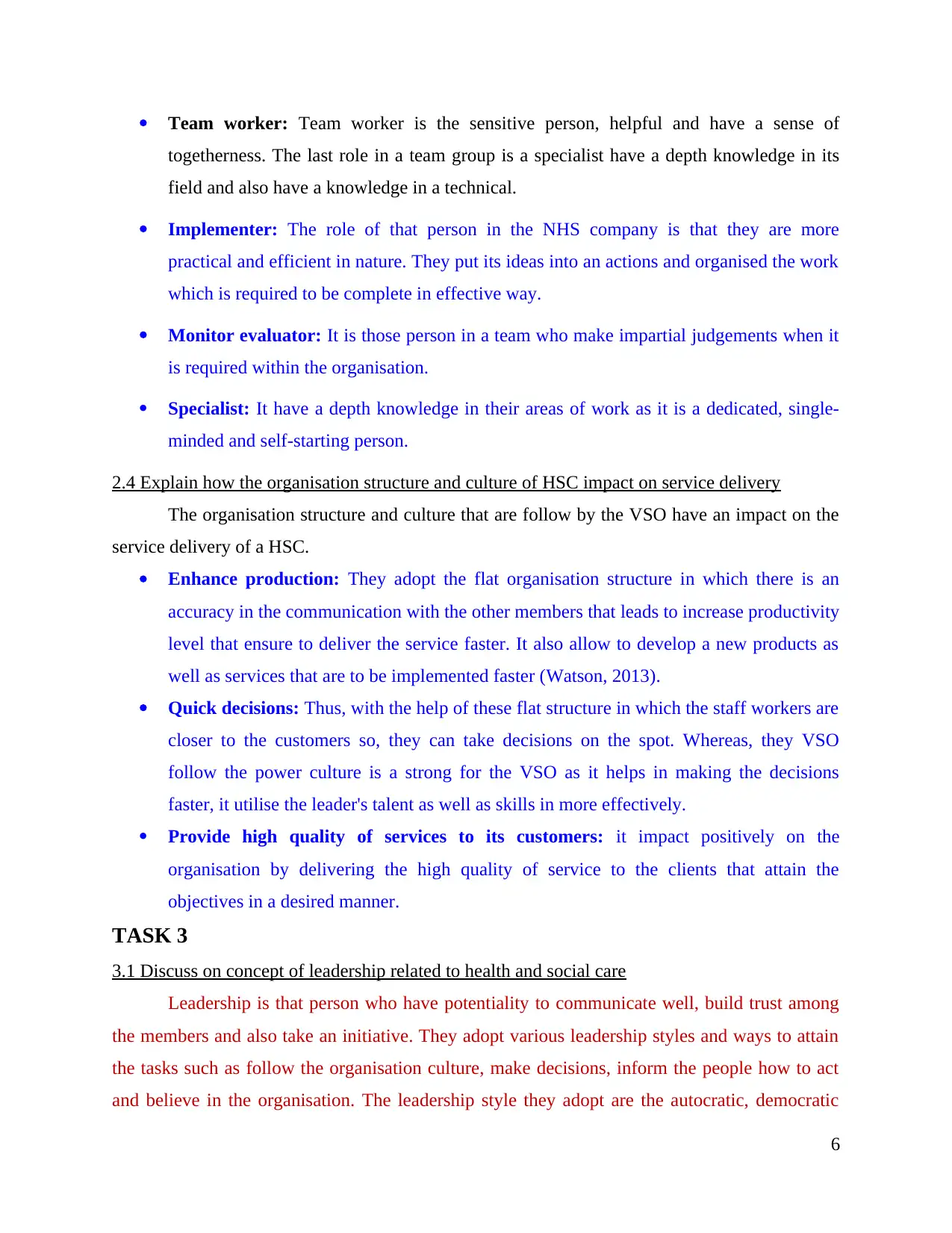
Team worker: Team worker is the sensitive person, helpful and have a sense of
togetherness. The last role in a team group is a specialist have a depth knowledge in its
field and also have a knowledge in a technical.
Implementer: The role of that person in the NHS company is that they are more
practical and efficient in nature. They put its ideas into an actions and organised the work
which is required to be complete in effective way.
Monitor evaluator: It is those person in a team who make impartial judgements when it
is required within the organisation.
Specialist: It have a depth knowledge in their areas of work as it is a dedicated, single-
minded and self-starting person.
2.4 Explain how the organisation structure and culture of HSC impact on service delivery
The organisation structure and culture that are follow by the VSO have an impact on the
service delivery of a HSC.
Enhance production: They adopt the flat organisation structure in which there is an
accuracy in the communication with the other members that leads to increase productivity
level that ensure to deliver the service faster. It also allow to develop a new products as
well as services that are to be implemented faster (Watson, 2013).
Quick decisions: Thus, with the help of these flat structure in which the staff workers are
closer to the customers so, they can take decisions on the spot. Whereas, they VSO
follow the power culture is a strong for the VSO as it helps in making the decisions
faster, it utilise the leader's talent as well as skills in more effectively.
Provide high quality of services to its customers: it impact positively on the
organisation by delivering the high quality of service to the clients that attain the
objectives in a desired manner.
TASK 3
3.1 Discuss on concept of leadership related to health and social care
Leadership is that person who have potentiality to communicate well, build trust among
the members and also take an initiative. They adopt various leadership styles and ways to attain
the tasks such as follow the organisation culture, make decisions, inform the people how to act
and believe in the organisation. The leadership style they adopt are the autocratic, democratic
6
togetherness. The last role in a team group is a specialist have a depth knowledge in its
field and also have a knowledge in a technical.
Implementer: The role of that person in the NHS company is that they are more
practical and efficient in nature. They put its ideas into an actions and organised the work
which is required to be complete in effective way.
Monitor evaluator: It is those person in a team who make impartial judgements when it
is required within the organisation.
Specialist: It have a depth knowledge in their areas of work as it is a dedicated, single-
minded and self-starting person.
2.4 Explain how the organisation structure and culture of HSC impact on service delivery
The organisation structure and culture that are follow by the VSO have an impact on the
service delivery of a HSC.
Enhance production: They adopt the flat organisation structure in which there is an
accuracy in the communication with the other members that leads to increase productivity
level that ensure to deliver the service faster. It also allow to develop a new products as
well as services that are to be implemented faster (Watson, 2013).
Quick decisions: Thus, with the help of these flat structure in which the staff workers are
closer to the customers so, they can take decisions on the spot. Whereas, they VSO
follow the power culture is a strong for the VSO as it helps in making the decisions
faster, it utilise the leader's talent as well as skills in more effectively.
Provide high quality of services to its customers: it impact positively on the
organisation by delivering the high quality of service to the clients that attain the
objectives in a desired manner.
TASK 3
3.1 Discuss on concept of leadership related to health and social care
Leadership is that person who have potentiality to communicate well, build trust among
the members and also take an initiative. They adopt various leadership styles and ways to attain
the tasks such as follow the organisation culture, make decisions, inform the people how to act
and believe in the organisation. The leadership style they adopt are the autocratic, democratic
6
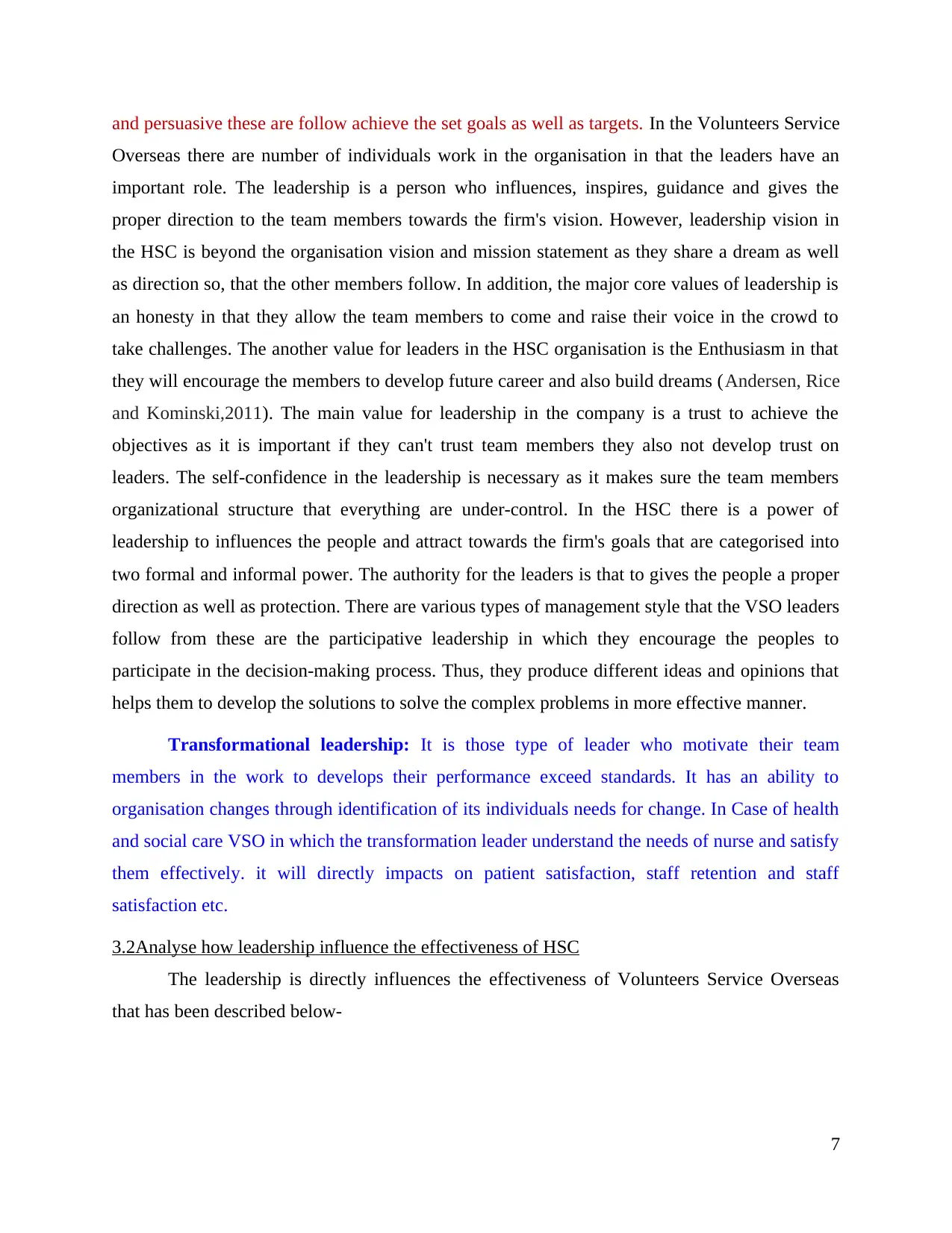
and persuasive these are follow achieve the set goals as well as targets. In the Volunteers Service
Overseas there are number of individuals work in the organisation in that the leaders have an
important role. The leadership is a person who influences, inspires, guidance and gives the
proper direction to the team members towards the firm's vision. However, leadership vision in
the HSC is beyond the organisation vision and mission statement as they share a dream as well
as direction so, that the other members follow. In addition, the major core values of leadership is
an honesty in that they allow the team members to come and raise their voice in the crowd to
take challenges. The another value for leaders in the HSC organisation is the Enthusiasm in that
they will encourage the members to develop future career and also build dreams (Andersen, Rice
and Kominski,2011). The main value for leadership in the company is a trust to achieve the
objectives as it is important if they can't trust team members they also not develop trust on
leaders. The self-confidence in the leadership is necessary as it makes sure the team members
organizational structure that everything are under-control. In the HSC there is a power of
leadership to influences the people and attract towards the firm's goals that are categorised into
two formal and informal power. The authority for the leaders is that to gives the people a proper
direction as well as protection. There are various types of management style that the VSO leaders
follow from these are the participative leadership in which they encourage the peoples to
participate in the decision-making process. Thus, they produce different ideas and opinions that
helps them to develop the solutions to solve the complex problems in more effective manner.
Transformational leadership: It is those type of leader who motivate their team
members in the work to develops their performance exceed standards. It has an ability to
organisation changes through identification of its individuals needs for change. In Case of health
and social care VSO in which the transformation leader understand the needs of nurse and satisfy
them effectively. it will directly impacts on patient satisfaction, staff retention and staff
satisfaction etc.
3.2Analyse how leadership influence the effectiveness of HSC
The leadership is directly influences the effectiveness of Volunteers Service Overseas
that has been described below-
7
Overseas there are number of individuals work in the organisation in that the leaders have an
important role. The leadership is a person who influences, inspires, guidance and gives the
proper direction to the team members towards the firm's vision. However, leadership vision in
the HSC is beyond the organisation vision and mission statement as they share a dream as well
as direction so, that the other members follow. In addition, the major core values of leadership is
an honesty in that they allow the team members to come and raise their voice in the crowd to
take challenges. The another value for leaders in the HSC organisation is the Enthusiasm in that
they will encourage the members to develop future career and also build dreams (Andersen, Rice
and Kominski,2011). The main value for leadership in the company is a trust to achieve the
objectives as it is important if they can't trust team members they also not develop trust on
leaders. The self-confidence in the leadership is necessary as it makes sure the team members
organizational structure that everything are under-control. In the HSC there is a power of
leadership to influences the people and attract towards the firm's goals that are categorised into
two formal and informal power. The authority for the leaders is that to gives the people a proper
direction as well as protection. There are various types of management style that the VSO leaders
follow from these are the participative leadership in which they encourage the peoples to
participate in the decision-making process. Thus, they produce different ideas and opinions that
helps them to develop the solutions to solve the complex problems in more effective manner.
Transformational leadership: It is those type of leader who motivate their team
members in the work to develops their performance exceed standards. It has an ability to
organisation changes through identification of its individuals needs for change. In Case of health
and social care VSO in which the transformation leader understand the needs of nurse and satisfy
them effectively. it will directly impacts on patient satisfaction, staff retention and staff
satisfaction etc.
3.2Analyse how leadership influence the effectiveness of HSC
The leadership is directly influences the effectiveness of Volunteers Service Overseas
that has been described below-
7
⊘ This is a preview!⊘
Do you want full access?
Subscribe today to unlock all pages.

Trusted by 1+ million students worldwide
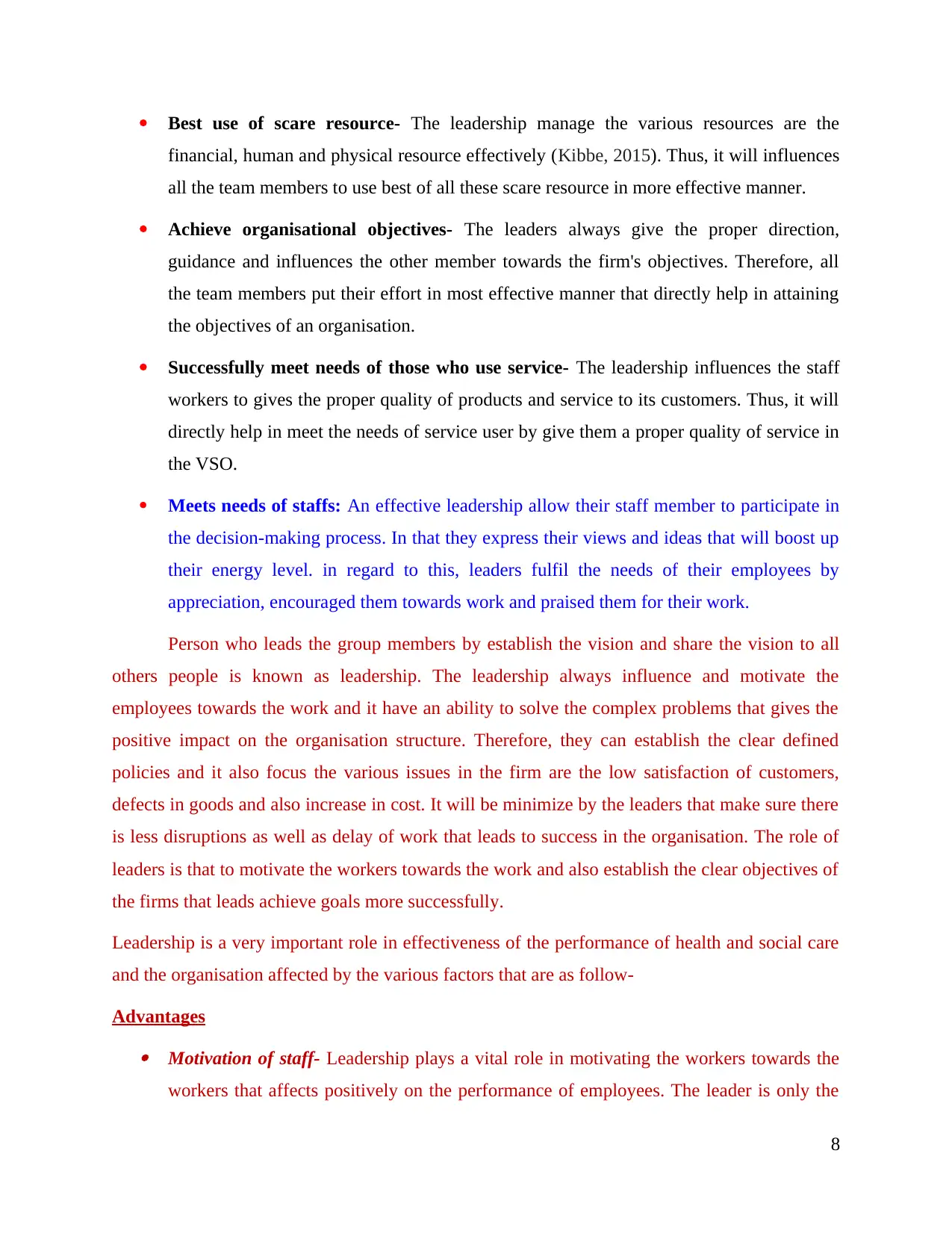
Best use of scare resource- The leadership manage the various resources are the
financial, human and physical resource effectively (Kibbe, 2015). Thus, it will influences
all the team members to use best of all these scare resource in more effective manner.
Achieve organisational objectives- The leaders always give the proper direction,
guidance and influences the other member towards the firm's objectives. Therefore, all
the team members put their effort in most effective manner that directly help in attaining
the objectives of an organisation.
Successfully meet needs of those who use service- The leadership influences the staff
workers to gives the proper quality of products and service to its customers. Thus, it will
directly help in meet the needs of service user by give them a proper quality of service in
the VSO.
Meets needs of staffs: An effective leadership allow their staff member to participate in
the decision-making process. In that they express their views and ideas that will boost up
their energy level. in regard to this, leaders fulfil the needs of their employees by
appreciation, encouraged them towards work and praised them for their work.
Person who leads the group members by establish the vision and share the vision to all
others people is known as leadership. The leadership always influence and motivate the
employees towards the work and it have an ability to solve the complex problems that gives the
positive impact on the organisation structure. Therefore, they can establish the clear defined
policies and it also focus the various issues in the firm are the low satisfaction of customers,
defects in goods and also increase in cost. It will be minimize by the leaders that make sure there
is less disruptions as well as delay of work that leads to success in the organisation. The role of
leaders is that to motivate the workers towards the work and also establish the clear objectives of
the firms that leads achieve goals more successfully.
Leadership is a very important role in effectiveness of the performance of health and social care
and the organisation affected by the various factors that are as follow-
Advantages Motivation of staff- Leadership plays a vital role in motivating the workers towards the
workers that affects positively on the performance of employees. The leader is only the
8
financial, human and physical resource effectively (Kibbe, 2015). Thus, it will influences
all the team members to use best of all these scare resource in more effective manner.
Achieve organisational objectives- The leaders always give the proper direction,
guidance and influences the other member towards the firm's objectives. Therefore, all
the team members put their effort in most effective manner that directly help in attaining
the objectives of an organisation.
Successfully meet needs of those who use service- The leadership influences the staff
workers to gives the proper quality of products and service to its customers. Thus, it will
directly help in meet the needs of service user by give them a proper quality of service in
the VSO.
Meets needs of staffs: An effective leadership allow their staff member to participate in
the decision-making process. In that they express their views and ideas that will boost up
their energy level. in regard to this, leaders fulfil the needs of their employees by
appreciation, encouraged them towards work and praised them for their work.
Person who leads the group members by establish the vision and share the vision to all
others people is known as leadership. The leadership always influence and motivate the
employees towards the work and it have an ability to solve the complex problems that gives the
positive impact on the organisation structure. Therefore, they can establish the clear defined
policies and it also focus the various issues in the firm are the low satisfaction of customers,
defects in goods and also increase in cost. It will be minimize by the leaders that make sure there
is less disruptions as well as delay of work that leads to success in the organisation. The role of
leaders is that to motivate the workers towards the work and also establish the clear objectives of
the firms that leads achieve goals more successfully.
Leadership is a very important role in effectiveness of the performance of health and social care
and the organisation affected by the various factors that are as follow-
Advantages Motivation of staff- Leadership plays a vital role in motivating the workers towards the
workers that affects positively on the performance of employees. The leader is only the
8
Paraphrase This Document
Need a fresh take? Get an instant paraphrase of this document with our AI Paraphraser

person who have an ability to motivate the workers so they can done their job or activities
accordingly.
Allocation of resources- The resources are very limited to the firm and the leadership
play a vital role to allocate these limited resources effectively by optimum utilization.
Therefore, the Volunteers Service overseas leaders take care of limited resources by
allocate them in best possible manner.
Disadvantage
Less productivity- VSO adopt the flat organisation structure if they autocratic leaders can
make their decision by their own. For this, workers not motivate with it that results turn
into they cannot make their maximum efforts leads to less productivity.
3.3 Evaluate the specific leadership contribution in HSC
In the Volunteers Service Overseas the leadership contribute by focusing on other people
these are the employees, superiors, colleagues and clients etc. Thus, they also treat them with
respect as well as openness that leads to motivate the team members. The other contribution of
leader on the work performance in that which it deals with the those people in a team and it role
as a implementer in which they set goals and make sure the strategy aligned constantly ( Gond,
Igalens, Swaen and El Akremi,2011 ). Therefore, the leader have a contribution in the NSC is
that they have an ability to make hard decisions and it mainly focus the important part and ignore
the unnecessary gap. The last contribution of leadership in the VSO is mainly contributing to
develop a talent by bringing together and also develop a sound strategies. Thus, they also
influence the people by communicating them towards the vision and respecting their ideas that
help them in motivating. Thereafter, there are more contribution of leadership in VSO has been
discussed below:-
Communicate effectively: The transformational leadership of VSO continuously
communicate with its team members through which they understand their needs. They
also develop transparent, open and mature with its members that increase trust and attain
the high levels of respects and recognition for HSC.
Continuously enforcement: The leaders contribute towards continuous to enforce when
needed it means that they protect their towards safeguard health, welfare and safety
9
accordingly.
Allocation of resources- The resources are very limited to the firm and the leadership
play a vital role to allocate these limited resources effectively by optimum utilization.
Therefore, the Volunteers Service overseas leaders take care of limited resources by
allocate them in best possible manner.
Disadvantage
Less productivity- VSO adopt the flat organisation structure if they autocratic leaders can
make their decision by their own. For this, workers not motivate with it that results turn
into they cannot make their maximum efforts leads to less productivity.
3.3 Evaluate the specific leadership contribution in HSC
In the Volunteers Service Overseas the leadership contribute by focusing on other people
these are the employees, superiors, colleagues and clients etc. Thus, they also treat them with
respect as well as openness that leads to motivate the team members. The other contribution of
leader on the work performance in that which it deals with the those people in a team and it role
as a implementer in which they set goals and make sure the strategy aligned constantly ( Gond,
Igalens, Swaen and El Akremi,2011 ). Therefore, the leader have a contribution in the NSC is
that they have an ability to make hard decisions and it mainly focus the important part and ignore
the unnecessary gap. The last contribution of leadership in the VSO is mainly contributing to
develop a talent by bringing together and also develop a sound strategies. Thus, they also
influence the people by communicating them towards the vision and respecting their ideas that
help them in motivating. Thereafter, there are more contribution of leadership in VSO has been
discussed below:-
Communicate effectively: The transformational leadership of VSO continuously
communicate with its team members through which they understand their needs. They
also develop transparent, open and mature with its members that increase trust and attain
the high levels of respects and recognition for HSC.
Continuously enforcement: The leaders contribute towards continuous to enforce when
needed it means that they protect their towards safeguard health, welfare and safety
9
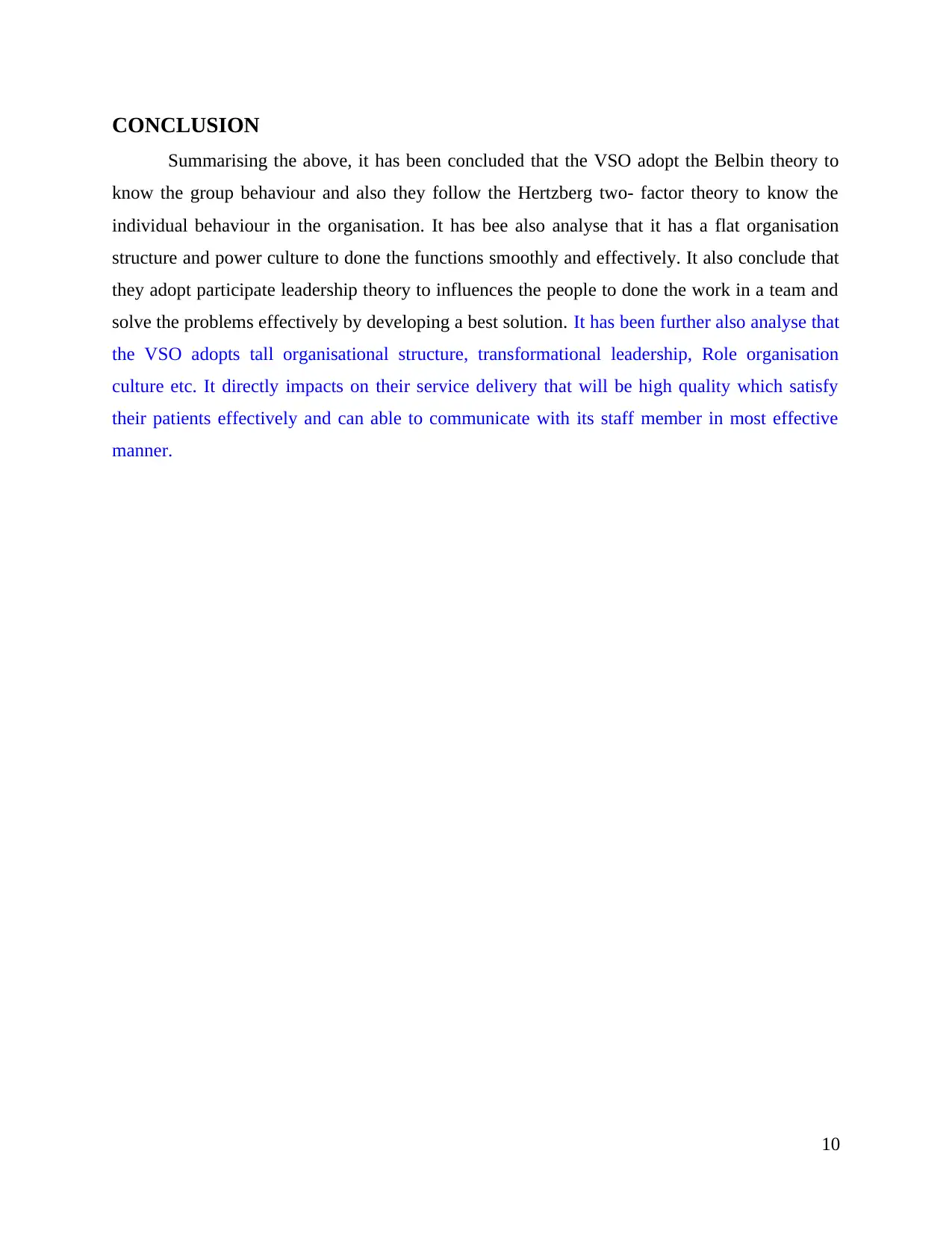
CONCLUSION
Summarising the above, it has been concluded that the VSO adopt the Belbin theory to
know the group behaviour and also they follow the Hertzberg two- factor theory to know the
individual behaviour in the organisation. It has bee also analyse that it has a flat organisation
structure and power culture to done the functions smoothly and effectively. It also conclude that
they adopt participate leadership theory to influences the people to done the work in a team and
solve the problems effectively by developing a best solution. It has been further also analyse that
the VSO adopts tall organisational structure, transformational leadership, Role organisation
culture etc. It directly impacts on their service delivery that will be high quality which satisfy
their patients effectively and can able to communicate with its staff member in most effective
manner.
10
Summarising the above, it has been concluded that the VSO adopt the Belbin theory to
know the group behaviour and also they follow the Hertzberg two- factor theory to know the
individual behaviour in the organisation. It has bee also analyse that it has a flat organisation
structure and power culture to done the functions smoothly and effectively. It also conclude that
they adopt participate leadership theory to influences the people to done the work in a team and
solve the problems effectively by developing a best solution. It has been further also analyse that
the VSO adopts tall organisational structure, transformational leadership, Role organisation
culture etc. It directly impacts on their service delivery that will be high quality which satisfy
their patients effectively and can able to communicate with its staff member in most effective
manner.
10
⊘ This is a preview!⊘
Do you want full access?
Subscribe today to unlock all pages.

Trusted by 1+ million students worldwide
1 out of 15
Related Documents
Your All-in-One AI-Powered Toolkit for Academic Success.
+13062052269
info@desklib.com
Available 24*7 on WhatsApp / Email
![[object Object]](/_next/static/media/star-bottom.7253800d.svg)
Unlock your academic potential
Copyright © 2020–2025 A2Z Services. All Rights Reserved. Developed and managed by ZUCOL.





